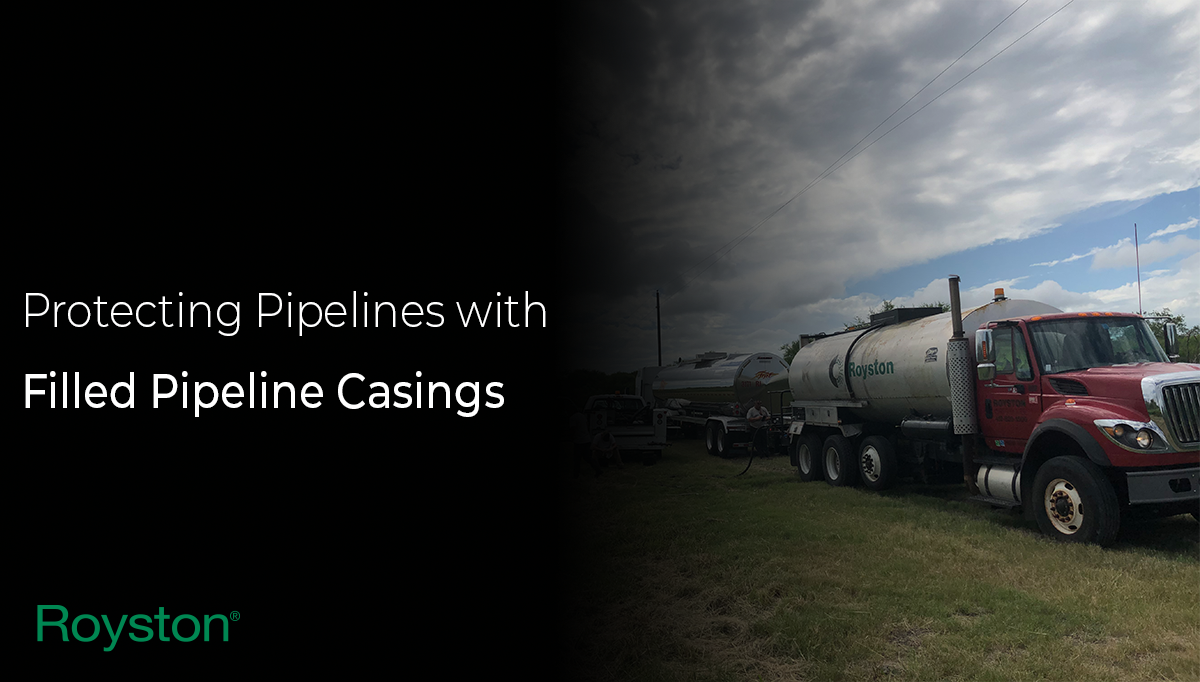Pipeline casings, also known as pipeline sleeves or conduits, are protective structures used to...
Protecting Pipelines with Filled Pipeline Casings

Pipeline casings, also known as pipeline sleeves or conduits, are protective structures used to encase pipelines that pass through various obstacles or environments. They serve to shield the pipeline from external forces, provide additional support, and prevent contact with potentially damaging elements. These casings are larger in diameter than the enclosed pipeline and are made from materials such as steel, concrete, or high-density polyethylene (HDPE).
Pipeline casings are commonly used in high-consequence environments where pipelines must pass under roads, railways, water bodies, or areas with geological features that could risk the pipeline’s integrity. The pipeline is safeguarded from potential damage caused by external factors like ground movement, vehicle traffic, or corrosion by installing a casing.
This blog will be our first in a series on pipeline casings. Stay tuned for the next blogs on how to fill pipeline casings (guidelines and a calculator) and our helpful checklist of considerations prior to filling a pipeline casing.
Pipeline Casings and Corrosion Protection Systems
Corrosion protection for pipeline casings is crucial to ensure the longevity and integrity of the pipelines. Several methods are commonly used to protect the casings from corrosion, including:
- External Coatings: Applying corrosion-resistant coatings, such as epoxy, polyurethane, tapes, or wax tapes, to the exterior of the pipe casing can provide a protective barrier against corrosive elements.
- Cathodic Protection: This method uses sacrificial anodes or impressed current systems to create an electrochemical reaction that prevents corrosion. It can be applied to both the pipeline itself and the casing.
- Corrosion Inhibitors: Materials such as petrolatum-based filler can be installed in between the pipe and the casing to inhibit corrosion by forming a protective film on the metal surface and/or altering the electrochemical environment.
In short, there are a variety of methods used to prevent corrosion and maintain a pipeline's functional service life. Each job site comes with its own particular needs and considerations, so choosing a specific method (or methods) requires a good deal of forethought. We have blogs on cathodic protection systems and general content on choosing the right protective pipeline coating you may find helpful in preparing for your next job.
Related Article: Protecting Against Pipeline Corrosion in High-Temp Environments
Why Fill Pipeline Casings - 5 Main Benefits
Pipeline casings are filled for several reasons:
1) Stability and Support
Filling the pipeline casings helps provide stability and support to the pipeline. It prevents the pipeline from shifting or sagging within the casing, maintaining its alignment and structural integrity.
2) Protection Against External Forces
Filling the casing creates a buffer between the pipeline and the external environment. It helps distribute external forces, such as soil pressure or water flow, more evenly across the casing, reducing stress on the pipeline.
3) Corrosion Prevention
By filling the casing with appropriate materials, corrosion of the pipeline can be mitigated. Corrosion can occur due to contact with soil, water, or other corrosive substances. The filling material acts as a protective layer, preventing direct contact between the pipeline and potentially corrosive elements.
4) Thermal Insulation
In some cases, pipeline casings are filled to provide thermal insulation. This is especially important for pipelines that transport fluids at different temperatures. The filling material helps maintain the desired temperature within the pipeline by reducing heat transfer to or from the surroundings.
5) Prevention of Water and Gas Intrusion
Filling the casing can help prevent the intrusion of water or gases into the pipeline. This is crucial to maintain the quality and safety of the transported fluid, particularly in cases where contamination or interaction with external substances could be detrimental.
Overall, filling pipeline casings serves multiple purposes, including stability, protection against external factors, corrosion prevention, thermal insulation, and maintaining the integrity of the transported fluid. The choice of filling material depends on various factors such as the specific application, environmental conditions, and the properties of the transported fluid.
Related Articles:
Job Site and Casing Preparation for Hot Wax Casing Fill (chasecorp.com)
In summary, pipeline casings are protective structures that enclose pipelines, providing support against external forces and potentially corrosive environments. The specific corrosion protection measures employed may vary depending on factors such as the type of pipeline, environmental conditions, and regulatory requirements (you can always identify a pipeline using our APWA pipe color code guide). It’s advisable to consult with corrosion engineers or pipeline experts to determine the most suitable corrosion protection strategy for a particular casing.
Topics: Royston, Corrosion Protection, Casing Fill, Hot Wax Casing Fill
Tapecoat and Royston tape coating systems provide corrosion protection to critical pipeline infrastructure. Our technical representatives can assist you with product information to meet your coating needs. Please contact us.






